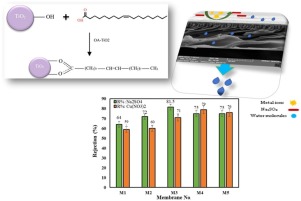Chemical Engineering Research and Design ( IF 3.7 ) Pub Date : 2020-02-25 , DOI: 10.1016/j.cherd.2020.02.019 Fahime Parvizian , Fatemeh Ansari , Samaneh Bandehali

|
In this study, hybrid nanofiltration (NF) membranes were fabricated by introducing oleic acid-titanium oxide (OA-TiO2) nanoparticles into the polyethersulfone (PES) by phase inversion method. The OA-TiO2 nanoparticles were synthesized and then different concentrations of synthesized nanoparticles were used to prepare NF membranes. The synthesized nanoparticles were characterized by Fourier transform infrared spectroscopy (FTIR), Field emission scanning electron microscopy (FESEM), and X-Ray Diffraction analysis (XRD). Moreover, the morphology of membranes was investigated by FESEM, the energy dispersive X-ray (EDX) analytical method, atomic force microscope (AFM) analysis. The separation performance of membranes was evaluated by the contact angle, pure water flux (PWF), flux recovery ratio (FRR%), and the rejection of Na2SO4 and Cu(NO3)2. The highest PWF (18.206 L/m2h) was obtained to PES-based membrane containing of 0.05 wt.% OA-TiO2 nanoparticles with a 42% increase compared with the pristine PES membrane at operating pressure of 4.5 bar due to increasing membrane hydrophilicity and better dispersion of OA-TiO2 nanoparticles. Furthermore, the best Na2SO4 rejection (81.5%) was obtained to membrane containing of 0.1 wt.% of OA-TiO2 nanoparticles and the highest Cu(NO3)2 removal (79%) was revealed to membranes containing of 0.5 wt.% OA-TiO2 nanoparticles that showed the increase of 21% and 25% compared to the pristine PES, respectively. The enhancement of salt rejection attributed to electrostatic repulsion and adsorption mechanisms. The incorporation of OA-TiO2 nanoparticles into the PES enhance FRR% to 83% that led to improving anti-fouling properties.
中文翻译:

油酸官能化的TiO 2纳米颗粒用于制备基于PES的纳滤膜
在本研究中,通过相转化法将油酸-氧化钛(OA-TiO 2)纳米粒子引入聚醚砜(PES)中,制备了混合纳米过滤(NF)膜。OA-TiO 2合成纳米颗粒,然后使用不同浓度的合成纳米颗粒制备NF膜。合成的纳米粒子通过傅立叶变换红外光谱(FTIR),场发射扫描电子显微镜(FESEM)和X射线衍射分析(XRD)进行表征。此外,通过FESEM,能量色散X射线(EDX)分析方法,原子力显微镜(AFM)分析研究了膜的形态。通过接触角,纯水通量(PWF),通量回收率(FRR%)以及Na 2 SO 4和Cu(NO 3)2的截留率来评价膜的分离性能。最高PWF(18.206 L / m 2h)获得了含有0.05 wt。%OA-TiO 2纳米粒子的PES基膜,与原始PES膜相比在4.5 bar的工作压力下增加了42%,这归因于膜亲水性的提高和OA-TiO 2的更好分散纳米粒子。此外,对于含有0.1 wt。%OA-TiO 2纳米颗粒的膜,Na 2 SO 4的排斥率最高(81.5%),而对于含有0.5%膜的膜,Cu(NO 3)2去除率最高(79%)。重量百分比OA-TiO 2与原始PES相比,纳米颗粒分别显示出21%和25%的增长。盐排斥的增强归因于静电排斥和吸附机制。将OA-TiO 2纳米颗粒掺入PES可将FRR%提高至83%,从而提高了防污性能。











































 京公网安备 11010802027423号
京公网安备 11010802027423号